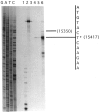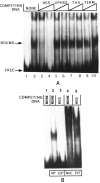Identification of a stable RNA encoded by the H-strand of the mouse mitochondrial D-loop region and a conserved sequence motif immediately upstream of its polyadenylation site
- PMID: 7537562
- PMCID: PMC6134379
Identification of a stable RNA encoded by the H-strand of the mouse mitochondrial D-loop region and a conserved sequence motif immediately upstream of its polyadenylation site
Abstract
By using a combination of Northern blot hybridization with strand-specific DNA probes, S1 nuclease protection, and sequencing of oligo-dT-primed cDNA clones, we have identified a 0.8 kb poly(A)-containing RNA encoded by the H-strand of the mouse mitochondrial D-loop region. The 5' end of the RNA maps to nucleotide 15417, a region complementary to the start of tRNA(Pro) gene and the 3' polyadenylated end maps to nucleotide 16295 of the genome, immediately upstream of tRNA(Phe) gene. The H-strand D-loop region encoded transcripts of similar size are also detected in other vertebrate systems. In the mouse, rat, and human systems, the 3' ends of the D-loop encoded RNA are preceded by conserved sequences AAUAAA, AAUUAA, or AACUAA, that resemble the polyadenylation signal. The steady-state level of the RNA is generally low in dividing or in vitro cultured cells, and markedly higher in differentiated tissues like liver, kidney, heart, and brain. Furthermore, an over 10-fold increase in the level of this RNA is observed during the induced differentiation of C2C12 mouse myoblast cells into myotubes. These results suggest that the D-loop H-strand encoded RNA may have yet unknown biological functions. A 20 base pair DNA sequence from the 3' terminal region containing the conserved sequence motif binds to a protein from the mitochondrial extracts in a sequence-specific manner. The binding specificity of this protein is distinctly different from the previously characterized H-strand DNA termination sequence in the D-loop or the H-strand transcription terminator immediately downstream of the 16S rRNA gene. Thus, we have characterized a novel poly(A)-containing RNA encoded by the H-strand of the mitochondrial D-loop region and also identified the putative ultimate termination site for the H-strand transcription.
Figures











Similar articles
-
Transcription termination at the mouse mitochondrial H-strand promoter distal site requires an A/T rich sequence motif and sequence specific DNA binding proteins.Eur J Biochem. 2003 Mar;270(6):1128-40. doi: 10.1046/j.1432-1033.2003.03461.x. Eur J Biochem. 2003. PMID: 12631272
-
Characterization of primary transcripts and identification of transcription initiation sites on the heavy and light strands of mouse mitochondrial DNA.Biochemistry. 1989 Jan 24;28(2):763-9. doi: 10.1021/bi00428a052. Biochemistry. 1989. PMID: 2713342
-
Identification of primary transcriptional start sites of mouse mitochondrial DNA: accurate in vitro initiation of both heavy- and light-strand transcripts.Mol Cell Biol. 1986 May;6(5):1446-53. doi: 10.1128/mcb.6.5.1446-1453.1986. Mol Cell Biol. 1986. PMID: 3785171 Free PMC article.
-
The transcription of DNA in chicken mitochondria initiates from one major bidirectional promoter.J Biol Chem. 1991 Jun 15;266(17):10844-50. J Biol Chem. 1991. PMID: 1710214
-
In D-loop: 40 years of mitochondrial 7S DNA.Exp Gerontol. 2014 Aug;56:175-81. doi: 10.1016/j.exger.2014.03.027. Epub 2014 Apr 4. Exp Gerontol. 2014. PMID: 24709344 Review.
Cited by
-
The effects of mitochondrial genotype on hypoxic survival and gene expression in a hybrid population of the killifish, Fundulus heteroclitus.Mol Ecol. 2011 Nov;20(21):4503-20. doi: 10.1111/j.1365-294X.2011.05290.x. Epub 2011 Oct 10. Mol Ecol. 2011. PMID: 21980951 Free PMC article.
-
Maintenance of respiratory chain function in mouse hearts with severely impaired mtDNA transcription.Nucleic Acids Res. 2010 Oct;38(19):6577-88. doi: 10.1093/nar/gkq527. Epub 2010 Jun 20. Nucleic Acids Res. 2010. PMID: 20566479 Free PMC article.
-
Detection and cDNA cloning of H-strand mitochondrial regulatory region RNAs in cultured human cells and human tissues.Cytotechnology. 2000 Jul;33(1-3):175-88. doi: 10.1023/A:1008154027997. Cytotechnology. 2000. PMID: 19002825 Free PMC article.
-
3D model of RNA polymerase and bidirectional transcription.Biochem Biophys Res Commun. 2007 Mar 30;355(1):103-10. doi: 10.1016/j.bbrc.2007.01.130. Epub 2007 Jan 31. Biochem Biophys Res Commun. 2007. PMID: 17288994 Free PMC article.
-
Mitochondrial transcription in mammalian cells.Front Biosci (Landmark Ed). 2017 Jan 1;22(5):835-853. doi: 10.2741/4520. Front Biosci (Landmark Ed). 2017. PMID: 27814650 Free PMC article. Review.
References
-
- Aloni Y. and Attardi G. (1971), J Mol Biol 28, 251–267. - PubMed
-
- Anderson S., Bankier A. T., Barrell B. G., de-Bruijn M. H., Coulson A. R., Drouin J., Eperon I. C., Nierlich D. P., Roe B. A., Sanger F., Schreier P. H., Smith A. J., Staden R., and Young I. G. (1981), Nature 290, 457–465. - PubMed
-
- Anderson S., de-Bruijn M. H., Coulson A. R., Eperon I. C., Sanger F., and Young I. G. (1982), J Mol Biol 156, 683–717. - PubMed
-
- Attardi G. and Schatz G. (1988), Annu Rev Cell Biol 4, 289–333. - PubMed
Publication types
MeSH terms
Substances
Grants and funding
LinkOut - more resources
Full Text Sources
